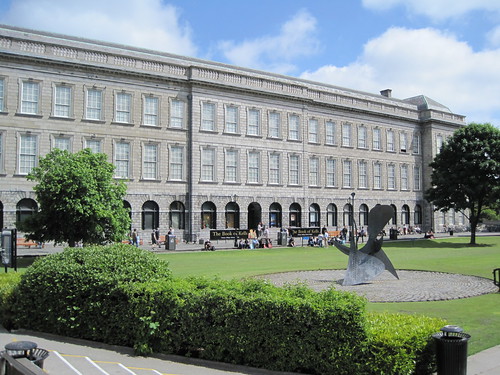5/25/10
P.S. (before the writing, I guess) –
In hindsight, I really wish I would’ve enjoyed this trip more than my post indicates I did. I think one of my bigger regrets from this trip was not really letting this gravity of the Book of Kells sink in. Go see this book if you get the chance and you have any interest in religion whatsoever.
This morning’s class inside the D4Berkeley was canceled in favor of a required trip to the Book of Kells inside Trinity College at Dublin’s City Centre. I can’t say as I was particularly looking forward to this even after having read the articles in our course pack. I’ve been to a lot of museums in my day and I’ve seen a lot of old stuff, so crossing an old book off the list didn’t seem to interest me.
We walked into a dark room with blown-up replicas of various pages, or folios, of the book itself lit up on the walls. I noticed on one of them that they pointed out Christ was flanked on both sides by peacocks with the Eucharist in their wings, but they didn’t explain why peacocks were used. I thought one of the karate forms I practice, Go Pei Sho, which is known as the advanced tearing peacock form. But Go Pei Sho is said to be from China. I wondered what, if any, connection the peacock holds between this book and the form. But I digress.
Every wall had information about the book and historical context, as well as some artifacts, and there were displays in the middle that had other tidbits. All of these explained something about the book. For example, the Book of Kells has been credited with being created around 800 AD and is essentially the Irish recreation of the four gospels of the Bible. It took four writers and I believe three artists to complete. One of the wall displays showed the letters that began the paragraphs, all of which were illustrated in great detail. I paid particular attention to the A, even sketching it in my impressions notebook.
The pages themselves are elaborately created, using feather and ink to write on vellum, or calfskin, pages. I noticed that like the historic books we saw in some of the churches yesterday, page registration marks looked like penciled-in lines and contained the text so it didn’t stray off on an angle or run into another line and the margins on each page were the same.
More than talking about just the book, the walls also illustrated a timeline of what else was happening in the world. It mentioned that nobody knows exactly when Christianity was introduced to Ireland, but there was a healthy population of Christians in 431 and the religion helped bring the written word to the island.
Up a handful of stairs was the Book of Kells itself in the middle of a room, encased in glass and opened up to a page with art, along with another copy opened up to a written page. The written page mentioned a passage Jesus apparently said to his disciples, which stated: “A prophet is not without honor save in his own country.”
On both sides of these were other books that were clearly not the main attraction, due to little prior advertisement and sheer size. They were roughly half the size of the Book of Kells.
Up two flights of stairs from the book was the Long Room, which was exactly that – a long room that was filled with two stories of books. At the end of each book rack was a bust of philosophers such as Aristotle, Plato, and Socrates, as well as some other names I’m sure are hailed in the annals of Irish history.
In the middle of the Long Room were cases of other old books and the recent artwork of schoolchildren. They weren’t as old as the Book of Kells, but were still hundreds of years old. One lady, who we discovered was from Iowa, remarked about one being “just another thirteen-hundred-year-old book.” She stole my thoughts right out of my head, minus her one-hundred-year math error.
Not having been too excited to go see this to begin with, I was glad the trip didn’t take long. I suppose it was nice being able to see the book, which, since its creation, has been replicated and distributed to universities throughout the world for further research.
I can now safely cross off “seeing a super old book” from my bucket list.


1 comment
Comments are closed.